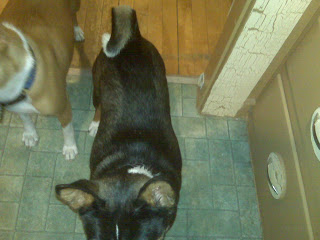 When we first adopted Kenya in April 2009, other than the dry course condition of her coat she looked like a typical tri with red/white/black markings on her face and black torso. It was interesting when we would take her for a walk. When the sun hit her body, little golden flecks would appear. It looked like a fairy sprinkled gold dust on her. Once she was out of the sun they weren't visible. With improved nutrition her coat got softer but a wierd thing started to happen. Around July/August, we started noticing small streaks of red/tan on her torso, hocks and behind her ears.
When we first adopted Kenya in April 2009, other than the dry course condition of her coat she looked like a typical tri with red/white/black markings on her face and black torso. It was interesting when we would take her for a walk. When the sun hit her body, little golden flecks would appear. It looked like a fairy sprinkled gold dust on her. Once she was out of the sun they weren't visible. With improved nutrition her coat got softer but a wierd thing started to happen. Around July/August, we started noticing small streaks of red/tan on her torso, hocks and behind her ears.
As time went on the red/tan streaks and patches kept spreading. We started joking that she heard us considering getting a 3rd basenji...a brindle and that she decided that she would turn into a trindle so her and Phoenix didn't have to share us with another dog. By October we couldn't believe how much the streaks/and patches had taken over her black coat.
Since then it seems like everyday it spreads more and more to different parts of her body.
The only pure black, other than her face is a streak down her back. Another thing that is happening is the red streaks and patches are getting lighter tan to cream and in some areas white is starting to spread.
Has anyone experienced anything like this with their B's? Any input, thoughts on why this would be happening would be welcomed!












You know, I was just looking at my tri-girl Reef yesterday and noticing some new lighter patches right behind her front shoulders. I thought maybe it was just her getting ready to shed or something (although she's never shed before)... maybe she's changing colors too!
ReplyDeleteShe did change colors once before, but that was by accident because I was putting peroxide on her leg every day to clean a wound. After about a week of peroxide swabs twice a day, her black fur started to bleach brown! Oops :) Thankfully, it grew back black, and her wound healed up just fine.
Its really starting to freak me out! It seems everyday she gets lighter and lighter. I think if it continues i'm going to have a white basenji with a tri-colored face!
ReplyDeleteMy red Bashir changes colors, too! He has a black stripe down his back, and sometimes gets a "saddle" on his sides. It's not as noticeable as yours, but it does change.
ReplyDeleteI think it's a basenji attempt at stealth technology.
Louise Mead said: Our purebred tri-colored basenji Carley, age 7, has undergone a similar change in coat color though perhaps not as dramatically. She has a very thick coat and a distinct undercoat. She loves cold weather & snow. The color changes are most noticeable in winter when her coat is thickest. I've joked that perhaps her Husky ancestors are showing their influence then. We have two brindles (strong red undercoat with dark brown/black stripes) & a red/white so she could be changing to blend in better:-). One other thought: Ingredients in the treats that we give our dogs might be affecting her coat color. They could also be affecting our other dogs' coats but the effect is less noticeable in them because of the natural red in their coats.
ReplyDeleteMy Basenji also has occasional color changes but they do sound like the above post, because he has a thicker coat than most and an undercoat..so he will "blow" his coat about every 2 years ....I have noticed that there seem to be two types of B's...shorter, fatter, thicker haired and long and skinny....
ReplyDeleteI have asked someone who is very "up" on the genetic basis of coat colors for her thoughts. She took a look and responded:
ReplyDelete"It appears to ME that something is breaking down the melanin (black) pigment in her coat. I don't think it is anything external/topical - something is going on internally if I had to guess."
One thought: Has Kenya been checked for thyroid disease?
She will ask some others who are knowledgeable. If I hear anything more, I'll post here.
Chey
Here's something you might check on:
ReplyDeletehttp://www.upei.ca/cidd/Diseases/dermatology/folliculardysplasia.htm
Also from the person I consulted:
"if the owners can locate a veterinary dermatologist who isn't miles and miles from them it might be worthwhile to get a prof. opinion what what is going on."
There is also a condition when the melanin breaks down & I would be concerned since you are starting to see white in the coat. Check with Jane Williams of Candu Basenjis. She had a beautiful black that turned almost pure white. The dog appeared healthy when I saw her at the nationals but Jane later found out the name of this condition. The sad part is that it also results in blindness.
ReplyDeleteThanks for all the feedback. First, does anyone know how to get in touch with Jane Williams of Candu Basenjis? The potential health causes concern me. On a lighter side...So many of your responses fit kenya to a tee! Hopefuly its not more than her attempt to change into a brindle so we don't get a 3rd dog. She does have a longer thicker coat. As the long black hairs have fallen out of her sides the remaining mismash of colors is shorter and more typical. The silly looking stripe down her back has longer and courser hairs. To my shock my Tenessee Rescue LOVES being outside in the cold. All summer her and Phoenix hung out in the house. We have a fenced in yard and it frustrated us they wouldn't use it. The winter and New Hampshire snow storms came and they love being outside...go figure. Just as I mentioned in one of the posts the color changes got worse as we progressed into the winter. The shedding started about 3 weeks ago and continues.
ReplyDeleteLinda, L Jane Williams and Katy Scott each had a basenji afflicted with the disease known as Uveodermatologic Syndrome, aka Vogt-Koyonagi-Harada Syndrome, an autoimmune disease that destroys the melanocytes, causing the skin/coat to loose pigment. It also destroys the retina, which can result in painful glaucoma and blindness. Katy recommends that you have Kenya's eyes checked by both her regular vet and an ophthalmologist to rule it out. Email me (rusenji@rochester.rr.com) and I'll forward Katy's note to you.
ReplyDeleteChey
the same thing is happening to my black and tan Basenji. I am concerned. She is almost 3 years old and I just noticed the changes over the past several weeks.
ReplyDeleteLinda, did you ever get an answer to what was happening to Kenya's coat and what did you end up doing to treat it? I am having the same issue with my tri boy; coat color changes, the thicker mohawk coat down his back, plus severe weight gain. The vet thought that it was a thyroid issue so we had him tested, his results came back fine. The vet recommended that we try a prescription diet thinking that his symptoms could be related to food allergies. I know that this post is a couple years old, but stumbled upon it and wondered what you ended up doing.
ReplyDeleteLinda:
ReplyDeleteI realize that your post is more than 9 years old, but the same problem has surfaced with my 4.5 year-old Basenji. So in case you still are involved with this Forum and with Basenjis, I need to know how was your dog's changing color problem resolved? Thanks for sharing anything that might help. Thanks.